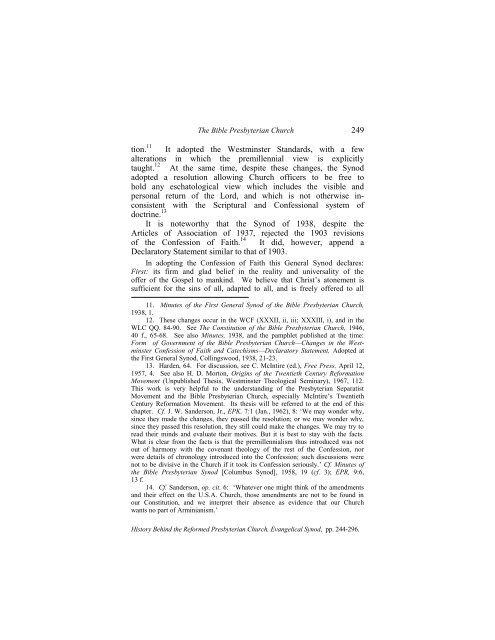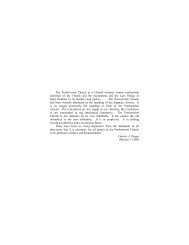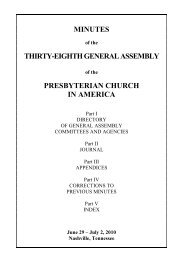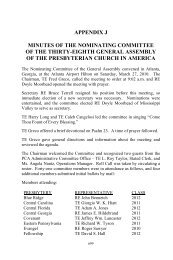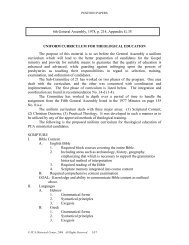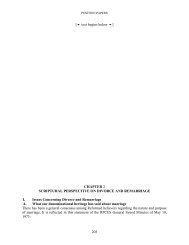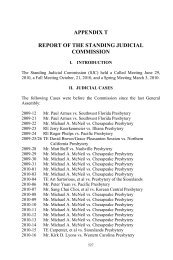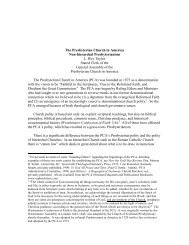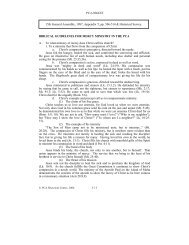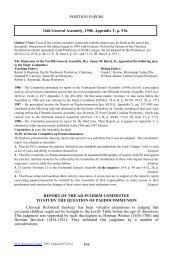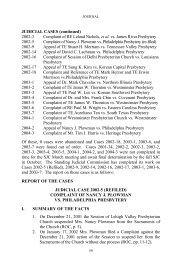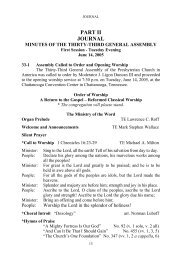Chapter 7: The Bible Presbyterian Church - PCA Historical Center
Chapter 7: The Bible Presbyterian Church - PCA Historical Center
Chapter 7: The Bible Presbyterian Church - PCA Historical Center
Create successful ePaper yourself
Turn your PDF publications into a flip-book with our unique Google optimized e-Paper software.
<strong>The</strong> <strong>Bible</strong> <strong>Presbyterian</strong> <strong>Church</strong> 249tion. 11 It adopted the Westminster Standards, with a fewalterations in which the premillennial view is explicitlytaught. 12 At the same time, despite these changes, the Synodadopted a resolution allowing <strong>Church</strong> officers to be free tohold any eschatological view which includes the visible andpersonal return of the Lord, and which is not otherwise inconsistentwith the Scriptural and Confessional system ofdoctrine. 13It is noteworthy that the Synod of 1938, despite theArticles of Association of 1937, rejected the 1903 revisionsof the Confession of Faith. 14 It did, however, append aDeclaratory Statement similar to that of 1903.In adopting the Confession of Faith this General Synod declares:First: its firm and glad belief in the reality and universality of theoffer of the Gospel to mankind. We believe that Christ‟s atonement issufficient for the sins of all, adapted to all, and is freely offered to all11. Minutes of the First General Synod of the <strong>Bible</strong> <strong>Presbyterian</strong> <strong>Church</strong>,1938, 1.12. <strong>The</strong>se changes occur in the WCF (XXXII, ii, iii; XXXIII, i), and in theWLC QQ. 84-90. See <strong>The</strong> Constitution of the <strong>Bible</strong> <strong>Presbyterian</strong> <strong>Church</strong>, 1946,40 f., 65-68. See also Minutes, 1938, and the pamphlet published at the time:Form of Government of the <strong>Bible</strong> <strong>Presbyterian</strong> <strong>Church</strong>—Changes in the WestminsterConfession of Faith and Catechisms—Declaratory Statement, Adopted atthe First General Synod, Collingswood, 1938, 21-23.13. Harden, 64. For discussion, see C. McIntire (ed.), Free Press, April 12,1957, 4. See also H. D. Morton, Origins of the Twentieth Century ReformationMovement (Unpublished <strong>The</strong>sis, Westminster <strong>The</strong>ological Seminary), 1967, 112.This work is very helpful to the understanding of the <strong>Presbyterian</strong> SeparatistMovement and the <strong>Bible</strong> <strong>Presbyterian</strong> <strong>Church</strong>, especially McIntire‟s TwentiethCentury Reformation Movement. Its thesis will be referred to at the end of thischapter. Cf. J. W. Sanderson, Jr., EPK, 7:1 (Jan., 1962), 8: „We may wonder why,since they made the changes, they passed the resolution; or we may wonder why,since they passed this resolution, they still could make the changes. We may try toread their minds and evaluate their motives. But it is best to stay with the facts.What is clear from the facts is that the premillennialism thus introduced was notout of harmony with the covenant theology of the rest of the Confession, norwere details of chronology introduced into the Confession; such discussions werenot to be divisive in the <strong>Church</strong> if it took its Confession seriously.‟ Cf. Minutes ofthe <strong>Bible</strong> <strong>Presbyterian</strong> Synod [Columbus Synod], 1958, 19 (cf. 3); EPR, 9:6,13 f.14. Cf. Sanderson, op. cit. 6: „Whatever one might think of the amendmentsand their effect on the U.S.A. <strong>Church</strong>, those amendments are not to be found inour Constitution, and we interpret their absence as evidence that our <strong>Church</strong>wants no part of Arminianism.‟History Behind the Reformed <strong>Presbyterian</strong> <strong>Church</strong>, Evangelical Synod, pp. 244-296.


